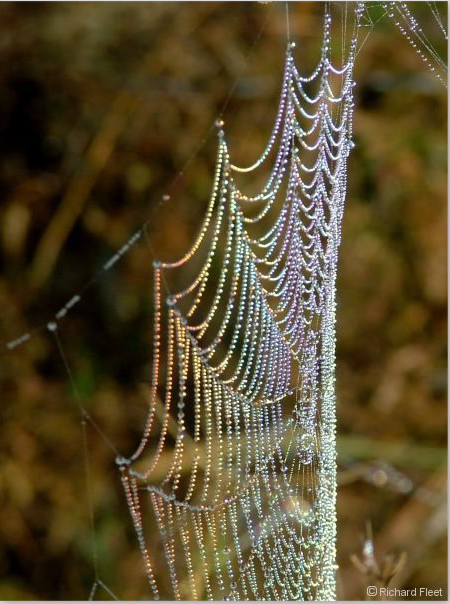Spide web rainbow
Spider Web Rainbow: A Natural Spectacle
When it comes to atmospheric optics, one of the most captivating and lesser-known phenomena is the spider web rainbow. This enchanting display occurs when dew condenses on a spider's web, creating a mesmerizing spectacle of rainbow colors. Captured in an image by Richard Fleet, this natural phenomenon showcases the intricate beauty of nature.
The spider web rainbow is a result of the interaction between light and water droplets on the web. As sunlight passes through the water droplets, it undergoes refraction, bending and separating into its component colors. This process is similar to what happens in a traditional rainbow, where raindrops act as the refracting medium. However, in the case of the spider web rainbow, the water droplets are much smaller, resulting in a more intricate and delicate display.
The key factor that sets the spider web rainbow apart is the intricate structure of the spider's web itself. The web's threads act as countless tiny prisms, dispersing and reflecting light in various directions. This scattering of light creates a stunning array of colors that seem to dance across the web's surface.
The spider web rainbow is most commonly observed in the early morning or late evening when dew forms on the web. During these times, the sun's angle is low, allowing for optimal light refraction and vivid coloration. The interplay between light, water droplets, and the web's structure creates a truly magical sight.
Each individual water droplet on the spider's web acts as a miniature prism, refracting and reflecting light independently. This results in multiple rainbows being formed simultaneously within the web, each with its own unique set of colors. The combination of these overlapping rainbows produces a dazzling display of hues that seems almost otherworldly.
The spider web rainbow serves as a reminder of the incredible complexity and beauty found in nature. It highlights the intricate interplay between light and water, showcasing the phenomenon of refraction in a unique and captivating way. This natural spectacle is a testament to the wonders that can be observed when we take the time to appreciate the small details that surround us.
Next time you come across a spider's web adorned with dew, take a moment to marvel at the enchanting display of colors. Observe how the sunlight interacts with the water droplets, creating a miniature rainbow within each one. It is in these moments that we can truly appreciate the marvels of atmospheric optics and the intricate beauty of our natural world.

Spider bow
Dew condensed on the web shines with rainbow colours.
Imaged by Richard Fleet (atmospheric optics).
©Richard Fleet, shown with permission
Note: this article has been automatically converted from the old site and may not appear as intended. You can find the original article here.
Reference Atmospheric Optics
If you use any of the definitions, information, or data presented on Atmospheric Optics, please copy the link or reference below to properly credit us as the reference source. Thank you!
-
<a href="https://atoptics.co.uk/blog/spide-web-rainbow/">Spide web rainbow</a>
-
"Spide web rainbow". Atmospheric Optics. Accessed on April 18, 2024. https://atoptics.co.uk/blog/spide-web-rainbow/.
-
"Spide web rainbow". Atmospheric Optics, https://atoptics.co.uk/blog/spide-web-rainbow/. Accessed 18 April, 2024
-
Spide web rainbow. Atmospheric Optics. Retrieved from https://atoptics.co.uk/blog/spide-web-rainbow/.